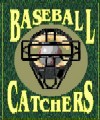 |
|
 |
|
|
A sure give-away to a hitter is for the catcher to give his signs and immediately set up inside or outside. A catcher should give the sign and location for the pitch he wants, and move to the location as the pitcher begins his motion. An important point is that the catcher should get his glove up and give the pitcher a target as early as possible. Again, donít give away the location too early, but still give the pitcher a reference point to focus in on. When a catcher is setting up for a fastball to be thrown right down the middle, the catcher should cheat slightly to the backhand side. The reason for this is that it is easier to move and catch an errant pitch to your glove hand side than it is to your backhand side. Unless you are calling for a pitch up in the strike zone, your glove should target the bottom of the zone. If the call is for low in the strike zone and if the target is mid-thigh and the pitcher hits his target, the ball may land 400 feet away. However, if the target is at the knee, the pitcher has a greater chance of success if he hits his spot. Both are low targets, but one could result in a homerun. Once the pitcher gets ahead in the count, the catcher should set up differently than if the pitcher is behind in the count. If an outside pitch is called, the catcher should set up off the plate about three inches. Having command of the strike zone will increase the chances that the umpire will give you the outer half. The same holds true for the inside pitch. The only difference is that instead of setting up three inches off the plate, you only need to set up one inch off the plate. It is important to remember one of the cardinal sins of baseball; never hit the batter when you have them down in the count. Once a pitcher falls behind in the count it takes away some of the latitude from the umpire and the catcher. If the catcher calls for a pitch away, he needs to set up on the outer third of the plate. You want the pitcher to hit the outer third, or the black. Again, the same holds true for the inside pitch. You donít want to fall behind even further. Set up on the corner and give the target on the plate. When a breaking ball is called, the catcher can still cheat slightly to the backhand side. Again, he must target the bottom of the zone. The glove must be at the knees. Mentally, the catcher must assume the ball will be in the dirt. Always be ready to block all balls in the dirt. When the pitcher gets ahead in the count and a breaking ball is called, the catcher will set up on the plate and want the ball down, or in the dirt. You want the hitter to chase the breaking ball and get himself out. Again, be ready to block all balls in the dirt. When the pitcher is behind in the count, the catcher should set up on the plate and target the bottom of the zone. In this case the catcher wants a breaking ball thrown for a strike. An important tip to the pitcher and the catcher; if you are going to miss, miss down and toward location. You wonít get hurt if you miss down. However, if you miss up in the zone, bad things will happen. |
